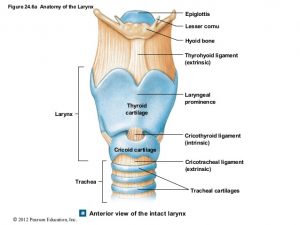LARYNX: Anatomy and function and MCQs For NEET, GPAT, UGC NET JRF
ANATOMY OF LARYNX.
LARYNX or voice box is a small passage that connects the laryngopharynx to the trachea. It lies in the midline of the neck and just anterior to the esophagus. The wall of larynx is made up of nine cartilages in which three occurs in pair while the rest three occur singly, the 3 cartilage that occur singly are thyroid cartilage , epiglottis and cricoid cartilage while arytenoid cartilage , corniculate cartilage and cuneiform cartilage occur in pairs. We will study about these cartilages in detail-
- THYROID CARTILAGE:-or ADAM’S APPLE is made by two fused plates of hyaline cartilage, it forms the anterior wall of larynx and is triangular in shape.it is present in both male and females but it is larger in males because of male sex hormones for growth during puberty. Thyroid cartilage is connected to hyoid bone through a ligament known as thyroid membrane.
- The EPIGLOTTIS:-it is a large piece of elastic cartilage and is covered by epithelium. Epiglottis is divided in 2 parts- the stem part is attached to anterior of thyroid cartilage and hyoid bone while the leaf part remains unattached is moves up and down freely. The glottis consist of a pair of vocal folds. Whenever small particles of dust food drink pass into the larynx, a cough occurs and hence expels them away.
- CRICOID CARTILAGE:-it is a ring of hyaline cartilage and forms the inferior wall of larynx. It is attached to thyroid cartilage through cricothyroid ligament and on distal end it is attached to trachea at cricotracheal ligament.
- ARYTENOID CARTILAGE:- they are triangular pieces of hyaline cartilage which lies on posterior superior side of cricoid cartilage. It articulates with cricoid cartilage by synovial joint and have great mobility.
- CORNICULATE CARTILAGE:- they are horn shaped pieces of elastic cartilage and lies at the apex of cricoid cartilage.
- CUNEIFORM CARTILAGE:- They are club shaped elastic cartilage which are located anterior to corniculate cartilage . They support the vocal cords and part of epiglottis.


FUNCTIONS OF LARYNX
The larynx performs several functions which are as follows
- SOUND PRODUCTION- sound mainly has 3 properties i.e pitch , resonance and volume
- pitch of the voice depends upon the length and tightness of the cords means that if the cords are shorter results in higher pitched sound. At puberty males’ vocal cords become larger in size hence results in lower pitched voice
- volume depends on the force with which the cords vibrate, greater the force the cords vibrate strongly and results in loud sound
- resonance also known as tone depends on the shape of mouth , facial muscles and the sinuses.
2. SPEECH- speech is produced when the sound is produced by the cords which is further amplified by lips tongue and mouth.
3. PROTECTION- from larynx the lower respiratory tract starts hence it protects the same. It prevents backflow of food back to pharynx by moving upwards. Also the epiglottis closes during swallowing which ensures that the food enters the esophagus and not the trachea.
4. Larynx helps in passageway of air from pharynx to trachea and also humidifies , filters and warms the air that passes by.
MULTIPLE CHOISE QUESTIONS(MCQs)
1. Where is larynx located?
A. posterior to esophagus B. midline of neck
C. superior to pharynx D. posterior to nasal and oral cavities
2. Larynx is made up of how many cartilages?
A. 6 B. 9
C. 12 D. 5
3. What connects the larynx to other structure of throat?
A. intrinsic muscle B. ligaments
C. tendons D. extrinsic muscle
4. Which of the following is also known as ADAM’S APPLE?
A. epiglottis B. thyroid cartilage
C. arytenoid cartilage D. corniculate cartilage
5. Which of the following statement is NOT true?
A. larynx lies anterior to esophagus
B. larynx is formed by 12 cartilages
C. epiglottis contains pair of vocal cords
D. intrinsic muscle connects all the cartilages together
6. Which of the following are present in pairs?
A. Arytenoids cartilage B. corniculate cartilage
C. cuneiform cartilage D. all of the above
7. Match the following
(a)ligament connect thyroid cartilage to hyoid bone 1. unattached
(b)cricotracheal ligament 2. Thyroid membrane
(c)the leaf of epiglottis 3. Cricothyroid ligament
(d)thyroid cartilage connect to cricoid cartilage 4. Connect cricoid to trachea
8. The lining of the larynx superior to the vocal folds is done by?
A. Non keratinized stratified squamous epithelium B. Mucous membrane
C. Pseudostratified ciliated columnar epithelium D. simple epithelium
9. Which of the following is formed by elastic cartilage?
A. thyroid cartilage B. cricoid cartilage
C. arytenoids cartilage D. none of the above
10. The sympathetic stimulation reaches larynx through which nerve?
A. Nerves of superior cervical ganglia B. vagus nerve
c. glossopharyngeal nerve D. laryngeal nerve
ANSWERS:-
1. midline of neck
2. 9
3. extrinsic muscle
4. thyroid cartilage
5. larynx is formed by 12 cartilage
6. all of the above
7. (a) – 2 (b) – 4 (c) – 1 (d) – 3
8. non keratinized squamous epithelium
9. none of the above
10. nerves of superior cervical ganglia
Participate in Free Online Test for GPAT
Participate in Online FREE Pharmacist TEST: CLICK HERE
Participate in Online FREE Drug Inspector TEST: CLICK HERE
REFERENCE:
1. Ross and Wilson-Anatomy and physiology in health and illness; 12th edition; page no.-: 246-248
2. Gerard J. Tortora -Principles of anatomy and physiology; edition twelfth ; page no.-: 879-880